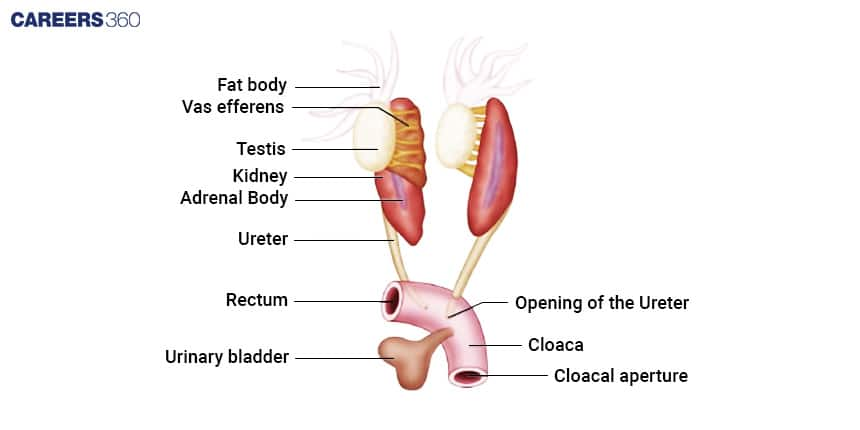Excretory System in Frog
The frog’s excretory system includes kidneys, ureters, bladder, and cloaca to regulate water, salts, and waste. Urine is formed through ultrafiltration, reabsorption, and secretion in nephrons. This makes frog excretion an important NEET biology topic for amphibian physiology.
This Story also Contains
- Introduction to Frog Excretory System
- Anatomy of the Frog Excretory System
- Functioning of the Frog’s Excretory System
- Kidneys in Frogs and Their Structure
- Urine Formation in Frogs
- Excretory System in Frogs NEET MCQs (With Answers & Explanations)
- Recommended video on "Excretory System in Frog"

Introduction to Frog Excretory System
In all animals, the system of ridding themselves of waste products of metabolism establishes homeostasis, the imperative state of the internal balance of water and salts in the body. The ability of cells to excrete toxic matter and regulate fluid levels leads to a system of adequate disposal of their functions. The simple and well-studied excretory system of the frog, of course, provides a great model to understand the processes by which alike mechanisms function in higher animals, including humans.
Anatomy of the Frog Excretory System
The excretory system of a frog composes organs that look into the excretion of metabolic wastes from the blood. The main organs include kidneys, ureters, urinary bladder, and cloaca. In simple terms, these four organs look after the filtering of blood from metabolic waste, the reabsorption of the necessary nutrients and the excretion of waste. These wastes are transmitted and secreted in urine.
Kidneys
The kidneys are the major excretory organs in frogs. They are a pair of dark, reddish‐brown, bean‐shaped organs located dorsolaterally along the backbone. Its main function is filtration and the maintenance of electrolytes, water, and acid‐base in the body.
Ureters
The ureters are narrow tubules that transfer urine from the kidneys to the urinary bladder. The male's ureters also carry sperm in the male frogs. Thus, they are part of both the excretory and reproductive systems.
Urinary bladder
The urinary bladder is sac-like and serves as a reservoir for urine before excretion. In frogs, the bladder is distensible and can hold a lot of urine. The role played by the urinary bladder is vital for water regulation and is inconsequential in aqueous media.
Cloaca
The cloaca is a common chamber at the end of the alimentary canal through which urine, faeces, and gametes are discharged. It forms the common chamber to the outlet of the urinary, reproductive and digestive systems in frogs.

Functioning of the Frog’s Excretory System
The functions of the excretory system of a frog are given below-
Filtration of Blood
The nephrons of the kidneys filter blood, removing waste products and forming urine. They regulate water, electrolyte and acid-base balance. This is initiated by the filtration of blood in the glomerulus to allow small molecules including water and ions to pass into the renal tubules from where the large molecules such as protein are retained.
Reabsorption and Secretion
After filtration, critical nutrients and water are then re-absorbed back into the bloodstream through the renal tubules, and additional waste products are contributed to the tubules. This is how urine composition is fine-tuned so that required substances are not swept out of the body as well as to expel toxins from the body.
Formation, Storage and Excretion of Urine
Urine is produced at the end of the processes of filtration, secretion and re-absorption. The urine finds its passage through the ureters to the urinary bladder, where it is stored until excretion. The chemical composition of frog urine is one constituent of internal homeostasis.
Kidneys in Frogs and Their Structure
The frog's kidneys are long, slender, and bean-shaped organs. They are simple structurally and functionally for an animal that has to spend part of its life on land and in the water. Frogs have a large number of nephrons in their kidneys. Nephrons are the functional units in kidneys responsible for the filtration of the blood and the formation of urine.
Nephrons
The detailed structure is described below:
Renal corpuscles
Each nephron consists of a renal corpuscle, which contains the glomerulus—a tuft of capillaries—and Bowman's capsule. The renal corpuscle is the site of blood filtering, within which water and small solutes succeed in passing into the renal tubules.
Renal tubules
The renal tubules represent a continuation in processing the filtrate from the renal corpuscles. Reabsorption and secretion represent the two functions carried out by the tubules to make the final adjustments to the urine before the urine leaves the kidney.
Urine Formation in Frogs
The urine formation in frogs is explained below-
Ultrafiltration in the Glomerulus
In the glomerulus, the pressure of blood forces water and solutes through the filtration membrane into Bowman's capsule. This process of separating waste from the blood initiates the formation of urine and is known as ultrafiltration.
Renal Tubules in Reabsorption and Secretion
After filtration, the filtrate thus enters the renal tubules. Here, selective reabsorption of water, glucose, and ions takes place. On the other hand, secretion of other waste occurs. This allows only useful substances to be held back while toxins and excess salts are got rid of.
Formation of Final Urine
The collecting network then collects this waste product, which is filtrated in the renal tubules, to be passed down the ureters. This is the final urine engendered after the reabsorption, and owing to this factor. It carries the end product of the kidney filtration as well as reabsorption.
Excretory System in Frogs NEET MCQs (With Answers & Explanations)
This topic carries a significant weightage in NEET exam. Important topics to be covered are:
Excretory System (with Diagram and labelling)
Components and Functioning of Excretory System
Urine formation in Frogs
Practice Questions for NEET
Q1. Which one of the following characteristics is common both in humans and adult frogs?
Internal fertilization
Nucleated RBCs
Ureotelic mode of excretion
Four - chambered heart
Correct answer: 3) Ureotelic mode of excretion
Explanation:
One common feature in both humans and frogs is that both the organisms are ureotelic, that is they excrete their nitrogenous waste in the form of urea. Being ureotelic allows both humans and frogs to efficiently excrete nitrogenous waste while conserving water. Urea, which is less toxic than ammonia, is produced in the liver through the urea cycle and is then transported to the kidneys for excretion. In humans, urea is filtered out of the blood by the kidneys and eliminated via urine. Frogs, like humans, also use their kidneys for filtration, but they may excrete waste through both their kidneys and their skin, depending on their environment. This adaptation helps conserve water, especially in terrestrial habitats.
Hence, the correct answer is option 3) Ureotelic mode of excretion.
Q2. When compared to the rabbit's venous system, the frog's venous system has
Hepatic Portal System
Renal Portal System
Hepatic vein
Three vena cava
Correct answer: 2) Renal portal system
Explanation:
Since the frog has a renal portal system, it differs from the rabbit's venous system. A femoral vein and a sciatic vein are formed when the capillaries that are getting the deoxygenated blood from the hind limb of the frog combine forces.
The hepatic portal system is part of the frog's venous system. Blood is transported to the liver by this route from the gastrointestinal tract and its related glands. It comprises a sizable portal vein that drains the liver and several tributaries that come from various organs.
The hepatic portal system is part of the frog's venous system. Blood is transported to the liver by this route from the gastrointestinal tract and its related glands. It comprises a sizable portal vein that drains the liver and several tributaries that come from various organs.
It can be found on the dorsal side of the heart and has a triangular form. It is created by joining the three main veins. There are one post-caval and two precavals. It opens into the right auricle and absorbs deoxygenated blood from the superior vena cava (precaval) and inferior vena cava (post caval).
Hence, the correct answer is option 2) Renal portal system
Q3. What is the functional unit of the excretory system in frogs?
Nephron
Glomerulus
Bowman’s capsule
Renal tubule
Correct answer: 1) Nephron
Explanation:
The nephron is the functional unit of the excretory system in frogs as well as in other vertebrates. It consists of a glomerulus, Bowman's capsule, and a renal tubule.
Glomerulus: It is a cluster of capillaries located within the Bowman's capsule in the kidney that filters blood to produce urine.
Bowman's capsule: It is a cup-shaped structure that surrounds the glomerulus in the kidney and receives filtered blood from the glomerulus.
Renal tubule: It is a long, twisted tube that begins with the Bowman's capsule and ends at the collecting duct. It is responsible for the reabsorption of water and important nutrients from the filtered blood, as well as the secretion of waste products into the urine.
Hence, the correct answer is option 1) Nephron.
Also Read:
Recommended video on "Excretory System in Frog"
Frequently Asked Questions (FAQs)
The frog's excretory system: kidneys, ureters, urinary bladder and cloaca
Frogs excrete nitrogenous waste mostly as urea although ammonia and uric acid is also found.
The kidneys filter blood, reabsorb useful matter, and secrete waste products to form urine.
Frogs manage their water balance in their bodies through their skin, kidneys and urinary bladder. That is why frogs can be either aquatic or terrestrial.
Parasitic infections and poisoning by pollutants are some common disorders of the frog's excretory system.